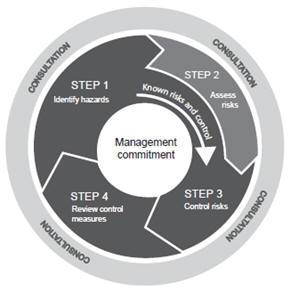Risk management
Western Sydney University has developed a WHS risk management system which outlines the systematic process for managing risks arising from workplace hazards.
WHS risk management within the University consists of four-steps, as described in the Code of Practice: How to manage work health and safety risks. These four steps are:
- Identify hazards - find out what could cause harm
- Assess risks - understand the nature of the harm that could be caused by the hazard, how serious the harm could be and the likelihood of it happening
- Control risks - implement the most effective control measure that are reasonably practicable in the circumstances
- Review control measures - ensure control measures are working as planned

The University's WHS risk management system is comprised of the following:
- Hazard Identification, Risk Assessment and Control Procedure
- Risk assessment form
- Travel risk assessment template
Information on specific hazards and risk management processes within the University can be found in through the Health and Safety Topics section of this website.
Frequently asked questions
What is a hazard?
Hazards are a situation or thing that has the potential to harm a person. Hazards at work may include: noisy machinery, a moving forklift, chemicals, electricity, working at heights, a repetitive job, bullying and violence at the workplace
What is a risk?
Risk is the possibility that harm (death, injury or illness) might occur when exposed to a hazard.
What is risk control?
Risk control means taking action to eliminate health and safety risks so far as is reasonably practicable, and if that is not possible, minimising the risks so far as is reasonably practicable. Eliminating a hazard will also eliminate any risks associated with that hazard.
Related Documents
- Hazard Identification, Risk Assessment and Control Procedure (PDF, 273.48 KB)
- Work Health and Safety Risk Assessment Form (DOCX, 52.1 KB)
- Work Health and Safety Risk Assessment Information Sheet (PDF, 511.31 KB)
- Fieldwork Safety Guidelines DOCX, 68.99 KB
- WHS Fieldwork/Outdoor Checklist (PDF, 217.12 KB)
- Fieldwork Acknowledgement Form (DOC, 1103 KB)
Mobile options:
